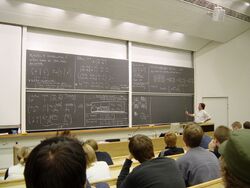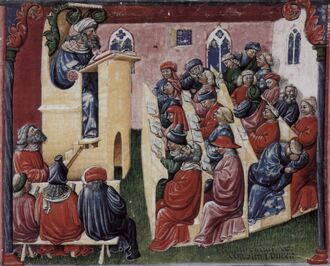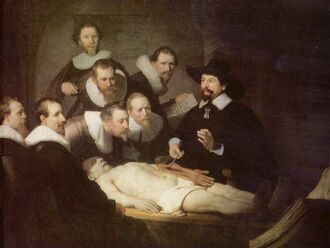No edit summary |
m (Reverted edits by 41.206.51.82 (talk | block) to last version by 124.43.49.224) |
||
| (5 intermediate revisions by 3 users not shown) | |||
| Line 1: | Line 1: | ||
{{EdPsy}} |
{{EdPsy}} |
||
| + | {{Teaching method}} |
||
[[image:Math lecture at TKK.JPG|thumb|250px|A lecture on [[linear algebra]] at the [[Helsinki University of Technology]]]] |
[[image:Math lecture at TKK.JPG|thumb|250px|A lecture on [[linear algebra]] at the [[Helsinki University of Technology]]]] |
||
| − | A '''lecture''' is an oral [[presentation]] intended to teach people about a particular subject, for example by a [[university]] or [[college]] [[teacher]]. Lectures are used to convey critical information, history, background, theories and equations. A politician's speech, a minister's sermon, or even a businessman's sales presentation may be similar in form to a lecture. Usually the lecturer will stand at the front of the room and recite information relevant to the lecture's content. |
+ | The '''lecture method''' is a [[teaching method]]. A '''lecture''' is an oral [[presentation]] intended to present information or teach people about a particular subject, for example by a [[university]] or [[college]] [[teacher]]. Lectures are used to convey critical information, history, background, theories and equations. A politician's speech, a minister's sermon, or even a businessman's sales presentation may be similar in form to a lecture. Usually the lecturer will stand at the front of the room and recite information relevant to the lecture's content. |
| − | Though lectures are much criticized, universities have not yet found practical alternative teaching methods for the large majority of their courses. Critics |
+ | Though lectures are much criticized as a [[pedagogy|pedagogical method]], universities have not yet found practical alternative teaching methods for the large majority of their courses. Critics point out that lecturing is mainly a one-way method of [[communication]] that does not involve significant audience participation. Therefore, lecturing is often contrasted to [[active learning]]. But lectures delivered by talented speakers can be highly stimulating; at the very least, lectures have survived in [[academia]] as a quick, cheap and efficient way of introducing large numbers of students to a particular field of study. |
| + | Lectures have a significant role outside the classroom, as well. Academic and scientific awards routinely include a lecture as part of the honor, and academic conferences often center around "[[keynote|keynote addresses]]", i.e., lectures. The [[public lecture]] has a long history in the sciences and in [[social movement]]s. [[Union hall]]s, for instance, historically have hosted numerous free and public lectures on a wide variety of matters. Similarly, [[church]]es, [[community center]]s, [[library|libraries]], [[museum]]s, and other organizations have hosted lectures in furtherance of their missions or their constituents' interests. |
||
| ⚫ | |||
| + | ==Etymology== |
||
The noun "lecture" dates from 14th century, meaning "action of reading, that which is read," from the [[Latin]] ''lectus'', pp. of ''legere'' "to read." Its subsequent meaning as "a discourse on a given subject before an audience for purposes of [[instruction]]" is from the 16th century. The verb "to lecture" is attested from 1590. |
The noun "lecture" dates from 14th century, meaning "action of reading, that which is read," from the [[Latin]] ''lectus'', pp. of ''legere'' "to read." Its subsequent meaning as "a discourse on a given subject before an audience for purposes of [[instruction]]" is from the 16th century. The verb "to lecture" is attested from 1590. |
||
| − | The noun "lectern" refers to the reading desk used by lecturers. In British English and several other languages the noun "lecture" must grammatically be the object of the verb "to read." |
+ | The noun "lectern" refers to the reading desk used by lecturers. In British English and several other languages the noun "lecture" must grammatically be the object of the verb "to read." |
| ⚫ | |||
| ⚫ | The practice in the [[ |
||
| + | [[Image:Laurentius de Voltolina 001.jpg|330px|left|thumb|A lecture at a medieval university (1350s) showing the lecturer reading a text from the lectern to students.]] |
||
| ⚫ | The practice in the [[medieval university]] was for the instructor to read from an original source to a class of students who took notes on the lecture. The reading from original sources evolved into the reading of glosses on an original and then more generally to lecture notes. Throughout much of history, the diffusion of knowledge via handwritten lecture notes was an essential element of academic life. |
||
| + | [[Image:Rembrandt Harmensz. van Rijn 007.jpg|330px|right|thumb|Rembrandt's The Anatomy Lecture of Dr. Nicolaes Tulp]] |
||
Even in the twentieth century the lecture notes taken by students, or prepared by a scholar for a lecture, have sometimes achieved wide circulation (see, for example, the genesis of [[Ferdinand de Saussure]]'s ''Cours de linguistique générale''). Many lecturers were, and still are, accustomed to simply reading their own notes from the lectern for exactly that purpose. Nevertheless, modern lectures generally incorporate additional activities, e.g. writing on a chalk-board, exercises, class questions and discussions, or student presentations. |
Even in the twentieth century the lecture notes taken by students, or prepared by a scholar for a lecture, have sometimes achieved wide circulation (see, for example, the genesis of [[Ferdinand de Saussure]]'s ''Cours de linguistique générale''). Many lecturers were, and still are, accustomed to simply reading their own notes from the lectern for exactly that purpose. Nevertheless, modern lectures generally incorporate additional activities, e.g. writing on a chalk-board, exercises, class questions and discussions, or student presentations. |
||
| − | The use of [[multimedia]] presentation software such as [[Microsoft PowerPoint]] has changed the form of lectures, e.g. video, graphics, websites, or prepared exercises may be included. Most commonly, however, only outlines composed of "bullet points" are presented. Critics contend that this style of lecture bombards the audience (as critics such as [[Edward Tufte]] put it) with unnecessary and possibly distracting or confusing graphics. Others simply think this form of lecture is non-spontaneous and boring. |
+ | The use of [[multimedia]] presentation software such as [[Microsoft PowerPoint]] has changed the form of lectures, e.g. video, graphics, websites, or prepared exercises may be included. Most commonly, however, only outlines composed of "bullet points" are presented. Critics contend that this style of lecture bombards the audience (as critics such as [[Edward Tufte]] [http://www.edwardtufte.com/bboard/q-and-a-fetch-msg?msg_id=0002PP&topic_id=1] put it) with unnecessary and possibly distracting or confusing graphics. Others simply think this form of lecture is non-spontaneous and boring. |
| − | |||
| ⚫ | |||
| ⚫ | |||
| + | [[Image:Hogarth lecture 1736.jpg|291px|right|thumb|[[William Hogarth]]'s 1736 [[engraving]], |
||
| + | ''Scholars at a Lecture'']] |
||
Bligh, in ''What's the Use of Lectures?'' argues that lectures "represent a conception of education in which teachers who know give knowledge to students who do not and are therefore supposed to have nothing worth contributing." Based on his review of numerous studies, he concludes that lecturing is as effective, but not more effective, as any other teaching method in transmitting information. Nevertheless, lecturing is not the most effective method for promoting student thought, changing attitudes, or teaching behavioral skills. |
Bligh, in ''What's the Use of Lectures?'' argues that lectures "represent a conception of education in which teachers who know give knowledge to students who do not and are therefore supposed to have nothing worth contributing." Based on his review of numerous studies, he concludes that lecturing is as effective, but not more effective, as any other teaching method in transmitting information. Nevertheless, lecturing is not the most effective method for promoting student thought, changing attitudes, or teaching behavioral skills. |
||
| − | == |
+ | ==Other forms== |
| ⚫ | Many [[university]] courses relying on lectures supplement them with smaller discussion sections, [[tutorial]]s, or laboratory experiment sessions as a means of further actively involving students. Often these supplemental sections are led by [[graduate student]]s, [[tutor]]s, [[Teaching Assistant]]s or Teaching [[Fellows]] rather than senior [[Faculty (university)|faculty]]. Those other forms of academic teaching include [[discussion]] ([[recitation]] if conducted by a Teaching Assistant ), [[seminar]]s, [[workshop]]s, [[observation]], practical application, [[case example]]s/[[case study]], [[experiental learning]]/[[active learning]], [[computer]]-based instruction and [[tutorial]]s. |
||
| − | |||
| − | [[image:Cambridge_lecture.jpg|thumb|250px|right|Students during a Saturday morning lecture at [[University of Cambridge|Cambridge University]]]] |
||
| ⚫ | Many [[university]] courses relying on lectures supplement them with smaller discussion sections or laboratory experiment sessions as a means of further actively involving students. Often these supplemental sections are led by [[graduate student]]s, [[Teaching Assistant]]s or Teaching [[Fellows]] rather than senior [[Faculty (university)|faculty]]. Those other forms of academic teaching include [[discussion]] ([[recitation]] if conducted by a Teaching Assistant ), [[seminar]]s, [[workshop]]s, [[observation]], practical application, [[case example]]s/[[case study]], [[experiental learning]]/[[active learning]], [[computer]]-based instruction and [[tutorial]]s. |
||
In [[school]]s the prevalent mode of student-teacher interaction is [[lesson]]s. |
In [[school]]s the prevalent mode of student-teacher interaction is [[lesson]]s. |
||
| − | |||
| − | ==Quote== |
||
| − | |||
| − | "Lectures," said McCrimmon, "are our most flexible art form. Any idea, however slight, can be expanded to fill fifty-five minutes; any idea, however great, can be condensed to that time. And if no ideas are available, there can always be discussion. Discussion is the vacuum that fills a vacuum. If no one comes to your lectures or seminars, you can have a workshop and get colleagues involved. They have to come, and your reputation as an adequately popular teacher is saved." ([[John Kenneth Galbraith]], ''[[A Tenured Professor]]'') |
||
== See also == |
== See also == |
||
| + | {{Wiktionary|lecture}} |
||
* [[public lecture]] |
* [[public lecture]] |
||
| − | == |
+ | ==References== |
| ⚫ | |||
| − | |||
| ⚫ | |||
| ⚫ | |||
| + | * [[Edward R. Tufte]]: ''The Cognitive Style of PowerPoint: Pitching Out Corrupts Within'' ([[Cheshire, Connecticut]]: [[Graphics Press]], 2006, 2nd edition). ISBN 0-9613921-5-0 [http://www.edwardtufte.com/tufte/powerpoint The Cognitive Style of PowerPoint] |
||
| ⚫ | |||
| − | |||
[[Category:Teaching]] |
[[Category:Teaching]] |
||
| Line 45: | Line 45: | ||
[[Category:Educational psychology]] |
[[Category:Educational psychology]] |
||
| + | ==External links== |
||
| + | * [http://www.lecturefox.com lecturefox.com]: free university lectures (videos, podcasts, notes) |
||
| + | * [http://www.world-lecture-project.org/ World Lecture Project (wlp°)]: free academic lectures from around the globe, covering all faculties |
||
| + | * [http://videolectures.net/ videolectures.net]: free academic lectures, especially on Computer Science |
||
| + | * [http://lecturefinder.com Lecturefinder]: Search academic and college grade lectures online. |
||
| + | |||
| + | <!-- |
||
| + | [[ar:محاضرة]] |
||
| + | [[bg:Лекция]] |
||
[[de:Vorlesung]] |
[[de:Vorlesung]] |
||
| + | [[ko:강의]] |
||
| + | [[id:Kuliah]] |
||
| + | [[he:הרצאה]] |
||
| + | [[nl:Hoorcollege]] |
||
| + | [[ja:講義]] |
||
| + | [[no:Forelesning]] |
||
| + | [[ru:Лекция]] |
||
| + | [[simple:Lecture]] |
||
| + | [[fi:Luento]] |
||
| + | [[sv:Föreläsning]] |
||
| + | [[uk:Лекція]] |
||
| + | --> |
||
{{enWP|Lecture}} |
{{enWP|Lecture}} |
||
Latest revision as of 19:37, 18 May 2010
Assessment |
Biopsychology |
Comparative |
Cognitive |
Developmental |
Language |
Individual differences |
Personality |
Philosophy |
Social |
Methods |
Statistics |
Clinical |
Educational |
Industrial |
Professional items |
World psychology |
Educational Psychology: Assessment · Issues · Theory & research · Techniques · Techniques X subject · Special Ed. · Pastoral

A lecture on linear algebra at the Helsinki University of Technology
The lecture method is a teaching method. A lecture is an oral presentation intended to present information or teach people about a particular subject, for example by a university or college teacher. Lectures are used to convey critical information, history, background, theories and equations. A politician's speech, a minister's sermon, or even a businessman's sales presentation may be similar in form to a lecture. Usually the lecturer will stand at the front of the room and recite information relevant to the lecture's content.
Though lectures are much criticized as a pedagogical method, universities have not yet found practical alternative teaching methods for the large majority of their courses. Critics point out that lecturing is mainly a one-way method of communication that does not involve significant audience participation. Therefore, lecturing is often contrasted to active learning. But lectures delivered by talented speakers can be highly stimulating; at the very least, lectures have survived in academia as a quick, cheap and efficient way of introducing large numbers of students to a particular field of study.
Lectures have a significant role outside the classroom, as well. Academic and scientific awards routinely include a lecture as part of the honor, and academic conferences often center around "keynote addresses", i.e., lectures. The public lecture has a long history in the sciences and in social movements. Union halls, for instance, historically have hosted numerous free and public lectures on a wide variety of matters. Similarly, churches, community centers, libraries, museums, and other organizations have hosted lectures in furtherance of their missions or their constituents' interests.
Etymology
The noun "lecture" dates from 14th century, meaning "action of reading, that which is read," from the Latin lectus, pp. of legere "to read." Its subsequent meaning as "a discourse on a given subject before an audience for purposes of instruction" is from the 16th century. The verb "to lecture" is attested from 1590. The noun "lectern" refers to the reading desk used by lecturers. In British English and several other languages the noun "lecture" must grammatically be the object of the verb "to read."
History

A lecture at a medieval university (1350s) showing the lecturer reading a text from the lectern to students.
The practice in the medieval university was for the instructor to read from an original source to a class of students who took notes on the lecture. The reading from original sources evolved into the reading of glosses on an original and then more generally to lecture notes. Throughout much of history, the diffusion of knowledge via handwritten lecture notes was an essential element of academic life.

Rembrandt's The Anatomy Lecture of Dr. Nicolaes Tulp
Even in the twentieth century the lecture notes taken by students, or prepared by a scholar for a lecture, have sometimes achieved wide circulation (see, for example, the genesis of Ferdinand de Saussure's Cours de linguistique générale). Many lecturers were, and still are, accustomed to simply reading their own notes from the lectern for exactly that purpose. Nevertheless, modern lectures generally incorporate additional activities, e.g. writing on a chalk-board, exercises, class questions and discussions, or student presentations.
The use of multimedia presentation software such as Microsoft PowerPoint has changed the form of lectures, e.g. video, graphics, websites, or prepared exercises may be included. Most commonly, however, only outlines composed of "bullet points" are presented. Critics contend that this style of lecture bombards the audience (as critics such as Edward Tufte [1] put it) with unnecessary and possibly distracting or confusing graphics. Others simply think this form of lecture is non-spontaneous and boring.
Research
William Hogarth's 1736 engraving, Scholars at a Lecture
Bligh, in What's the Use of Lectures? argues that lectures "represent a conception of education in which teachers who know give knowledge to students who do not and are therefore supposed to have nothing worth contributing." Based on his review of numerous studies, he concludes that lecturing is as effective, but not more effective, as any other teaching method in transmitting information. Nevertheless, lecturing is not the most effective method for promoting student thought, changing attitudes, or teaching behavioral skills.
Other forms
Many university courses relying on lectures supplement them with smaller discussion sections, tutorials, or laboratory experiment sessions as a means of further actively involving students. Often these supplemental sections are led by graduate students, tutors, Teaching Assistants or Teaching Fellows rather than senior faculty. Those other forms of academic teaching include discussion (recitation if conducted by a Teaching Assistant ), seminars, workshops, observation, practical application, case examples/case study, experiental learning/active learning, computer-based instruction and tutorials.
In schools the prevalent mode of student-teacher interaction is lessons.
See also
Look up this page on
Wiktionary:
lecture
- public lecture
References
- Donald A. Bligh: What's the Use of Lectures? (San Francisco: Jossey-Bass, 2000). ISBN 0-7879-5162-5
- Konrad Paul Liessmann: Über den Nutzen und Nachteil des Vorlesens. Eine Vorlesung über die Vorlesung (Vienna: Picus, 1994) ISBN 3-85452-324-6 [2].
- Edward R. Tufte: The Cognitive Style of PowerPoint: Pitching Out Corrupts Within (Cheshire, Connecticut: Graphics Press, 2006, 2nd edition). ISBN 0-9613921-5-0 The Cognitive Style of PowerPoint
External links
- lecturefox.com: free university lectures (videos, podcasts, notes)
- World Lecture Project (wlp°): free academic lectures from around the globe, covering all faculties
- videolectures.net: free academic lectures, especially on Computer Science
- Lecturefinder: Search academic and college grade lectures online.
| This page uses Creative Commons Licensed content from Wikipedia (view authors). |
